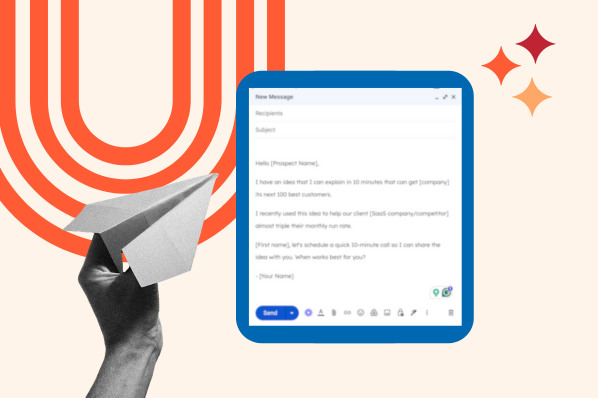In my experience, radio silence from a prospect is one of the worst experiences for a salesperson. When that happens to me, I like to use a breakup email to determine whether I should move on or if the sale can be saved.
Specifically, I’ve found that breakup emails help close the communication loop because they either confirm that a prospect isn’t interested at the moment or give the person enough urgency to re-engage in our conversation. Either way, I consider them my way out of the dreaded silence or “maybe” that can keep me guessing and waste time and resources.
Download Now: 50 Sales Email Templates
[Free Access]
Table of Contents
- What is a client breakup email?
- Why You Should Close the Loop in Sales Emails
- How to Write a Breakup Email
- 7 Closing the Loop Email Examples
What is a client breakup email?
It’s called a breakup email, but the last thing I want is to break up with a prospect. A breakup email is a final message sent as an attempt to salvage a sale.
It’s typically the last email in an automated campaign, and it only gets sent if the prospect hasn’t responded to any other message in the email sequence.
The goal of a breakup email is to restart the conversation, and they work. According to Katharine Fischer, enterprise account manager at HubSpot, her sales team sees a 33% response rate to their breakup emails.

50 Free Sales Email Templates
Save time, find new ways to reach out to prospects, and send emails that actually convert.
- First-Touch Emails
- Follow-Up Emails
- Break-Up Emails
- ChatGPT Email Prompts
Download Free
All fields are required.

Why You Should Close the Loop in Sales Emails
I find that using breakup emails helps me effectively make decisions on how to spend my time. They either revitalize a sale or close the loop with prospects who aren’t interested so I can focus on more engaged leads in the sales process. That’s why some salespeople call breakup emails close file emails or closing the loop emails.
In addition to helping me put a pin in inactive files, I’ve found that breakup emails also foster a more positive relationship with prospects. It builds goodwill by asking if they want to hear from me and showing that I understand if they’re too busy to respond.
People may reply and say they were interested but were too busy to reply to my first messages. Others might say the timing wasn’t right, but they want to reconnect in a few months. Either way, if I had just ghosted those prospects, I would have missed those opportunities and left them feeling like I didn’t care.
How To Write a Breakup Email

I find that writing emails to close the loop is much easier than it seems at first. After all, these aren’t novels, just short messages with a specific purpose. When I write breakup emails, I make sure to include four parts: a clear subject, personalization, a value-add, and a call to action.
1. Write with a straightforward subject line.
In my experience, breakup email subject lines perform best when it’s clear that I’m closing the loop. So, I recommend keeping subject lines short and to the point. One study found that subject lines with seven words have the highest open rates at 46.2%.
Try these compelling subject lines for your next closing-the-loop email:
- Is this goodbye [prospect name]?
- Thanks for your time — closing the loop.
- Goodbye from [company name], one last resource inside.
2. Personalize your message.
As a reader, generic emails don’t convince me to open them. So, I always find a way to personalize my emails using HubSpot’s email marketing tools.
I start by personalizing the subject line to grab the attention of readers like me, as personalization can make prospects 50% more likely to open your email. I also like to use the prospect’s name and mention their brand in the body copy when it’s a B2B email outreach.
3. Provide value.
I like to include something of value in my breakup emails to show prospects that I want to help them and am focused more on the relationship than just the transaction. If I want to keep the email short, I restate my value proposition.
Other times, I may include resources like ebooks or case studies relevant to their pain points. In addition to providing value, it encourages them to stay engaged with our brand even if they’re not ready to buy just yet.
4. Add your call to action.
I believe that most (if not all) sales emails need a clear call to action. For a breakup email, I’ll ask the potential customer to tell me if they want to keep the conversation open or to confirm they’re not interested at the moment so I know to stop reaching out.

50 Free Sales Email Templates
Save time, find new ways to reach out to prospects, and send emails that actually convert.
- First-Touch Emails
- Follow-Up Emails
- Break-Up Emails
- ChatGPT Email Prompts
Download Free
All fields are required.

7 Closing the Loop Email Examples
Since sales breakup emails are short and sweet, I’ve found that using templates for client breakup emails makes the best use of my time and improves response rates for my email campaigns. Here are some of my favorite templates.
1. The “I’m here to help.”
Prospects have no incentive to speak with a sales rep who’s only interested in the deal for quota’s sake. This template reinforces that you want to help, not just make a sale.
Hi [Prospect name],
Haven’t heard from you in a while.
We last spoke about your concerns about [pain point] and how [offering] could help [achieve specific goal] over [specific timeframe].
Are you still interested in continuing our discussion? If not, please let me know so I can stop reaching out.
Best,
[Your name]
What I like: This email is all about the prospect. It shows that you paid attention to their pain points and reiterates your value proposition.
2. The “short and sweet” goodbye.
I’ve personally discovered that short and simple provides the best results when writing breakup emails, which is why I like this follow-up email that gets right to the point.
Hi [Prospect name],
Apologies if my level of persistence has become annoying.
Are you still interested in speaking about your [pain point], specifically how [offering] can help with [X] and [Y]?
If not, please let me know, and I will stop reaching out.
Best,
[Your name]
What I like: This template uses personalization and gives prospects information without wasting time, making it great for those with a lot on their plates.
3. The “magic email plus.”
This was inspired by “the magic email” originally crafted by Blair Enns of Win Without Pitching. It’s a reference I often return to because it takes emotion out of the equation and maintains a professional, strictly business tone that can make the breakup conversation more comfortable for prospects.
Hi [Prospect name],
I haven’t heard back from you regarding [product/service], so I’m assuming you’re trying a different solution or have changed priorities.
If we can be of assistance now or in the future, please feel free to reach out.
Best,
[Your name]
What I like: This email acknowledges a likely lost sale without assigning emotion to it. However, it leaves the door open for the prospect if the competitor’s option they likely bought isn’t working out well by saying they are “trying out” a solution to suggest it isn’t final.
When I use this client breakup email template, I’m letting them know it’s okay if it is or isn’t working out, and I’m here to help anytime without putting any pressure on them.

50 Free Sales Email Templates
Save time, find new ways to reach out to prospects, and send emails that actually convert.
- First-Touch Emails
- Follow-Up Emails
- Break-Up Emails
- ChatGPT Email Prompts
Download Free
All fields are required.

4. The “going away present.”
This value-added template is one of my favorite breakup emails because I know I have great resources to share with a potential prospect.
Hello [Prospect name],
I‘ve reached out a couple of times to connect regarding [business goal]. Since I haven’t heard back from you, I'll assume that now isn’t the right time.
In the meantime, I wanted to share some free resources for brands like yours that are facing [business challenge].
- Link to resource 1
- Link to resource 2
- Link to resource 3
If it makes sense to reconnect in the future, you can always book time on my calendar here.
Best,
[Your name]
What I like: Everyone loves something free, and this message gives prospects who aren’t ready to say goodbye just yet a reason to stay interested. Combining that with a convenient self-service way to set up a meeting at their convenience creates goodwill with potential customers who might need more time.
5. The “Hi from the CEO.”
My experience has taught me that sometimes prospects find a salesperson easy to ignore, but they’re more likely to engage with a message from my company's CEO. If I suspect that’s the case, I’ll check with my CEO to see if I can draft an email in their name. I then ask them to send the message I wrote using their email address and forward any response.
Hello [Prospect name],
I’m [CEO name], the CEO of [Company name]. [Sales rep name] told me that you recently received a demo of our product, and I wanted to reach out personally to hear your thoughts on [offering].
Your business matters to us, and I'd like to help in any way I can.
Thank you,
[CEO name]
What I like: By referencing the last conversation touchpoint (the demo), you can gloss over their lack of communication, which avoids putting negative pressure on the prospect. Plus, the email coming directly from the CEO’s email makes the prospect feel like a valued contact and creates a positive impression.
6. The “see you later.”
In my experience, when a prospect goes silent, it doesn't always mean “No.” It could simply mean, “Now’s not the right time.” This template is my go-to when I plan to pause outreach temporarily.
Hello [Prospect name],
It’s been a while since I heard back from you, so I‘ll assume [product/service name] isn’t a priority at the moment. I understand and don't want to continue taking up your time.
I'll reach out in [timeframe] to see if our goals are more aligned.
Sincerely,
[Your name]
Pro tip: Follow up.
Following up is important with this closing-the-loop email template. When it’s time to reach out again, I prefer starting with a fresh email chain. I’ll typically send a neutral message to start a conversation organically by referencing something that’s of interest to them.
For example:
“Hi [Prospect name]!
How've you been? I saw a press release that your company will be at Trade Show [X] this summer. Let me know if you’ll be there, and we can grab a coffee.”
What I like: By keeping things casually friendly and open rather than jumping right to “Are you ready to buy,” you can restart the conversation and keep future opportunities alive.
7. The “What do you think?”
Along the same lines as starting a new discussion, I’ve found that asking prospects for their opinion helps restart communications when their replies lapse. You can ask about something product- or deal-related or their work or industry.
Hi [Prospect name],
I saw that [prospect's company]’s new product just launched. Congratulations! How was that experience for your team?
Cheers,
[Your name]
What I like: This takes the sales pressure away from the email while keeping it focused on business. Plus, it gives a chance for a more personal connection to help you learn about their current wins and pain points.
Achieve Clarity and Improve Your Conversions With Proven Email Templates
Breakup emails are one of the most useful tools in my sales kit. They can be a valuable way to jumpstart a lagging relationship or confirm that it’s time for you to move on.
Whatever your prospect says, you’ll know exactly where you stand so you can spend your time and resources wisely. And if you’re ready to freshen up your outreach material with new prospecting and sales templates, we've got you covered.

Email Templates







.jpg)

![What to Do When Your Prospect Ghosts [Free No-Show Follow-Up Email Templates]](https://53.fs1.hubspotusercontent-na1.net/hubfs/53/no-show-prospects-templates_3.webp)

